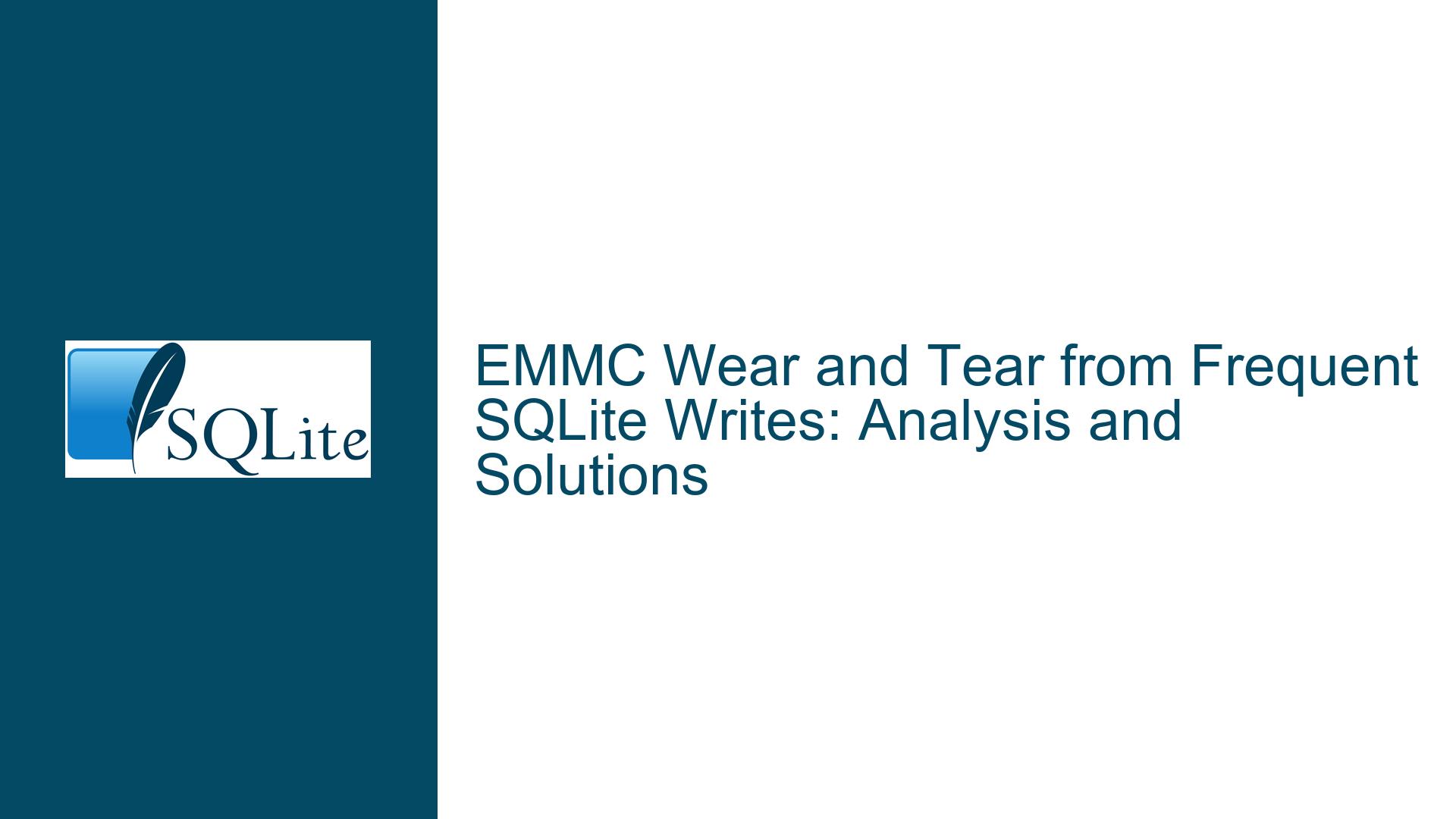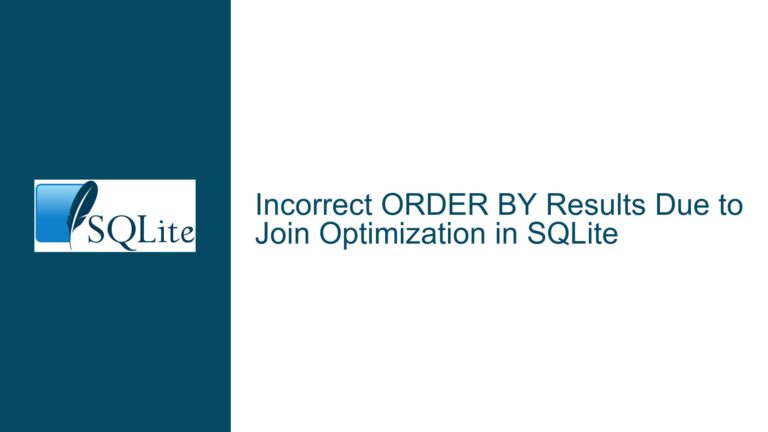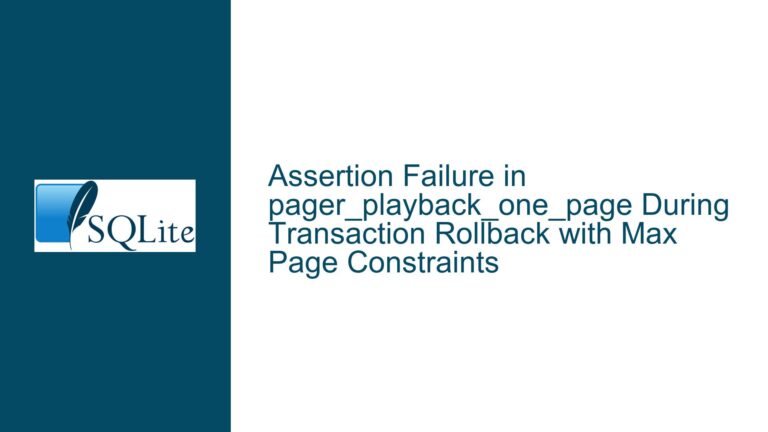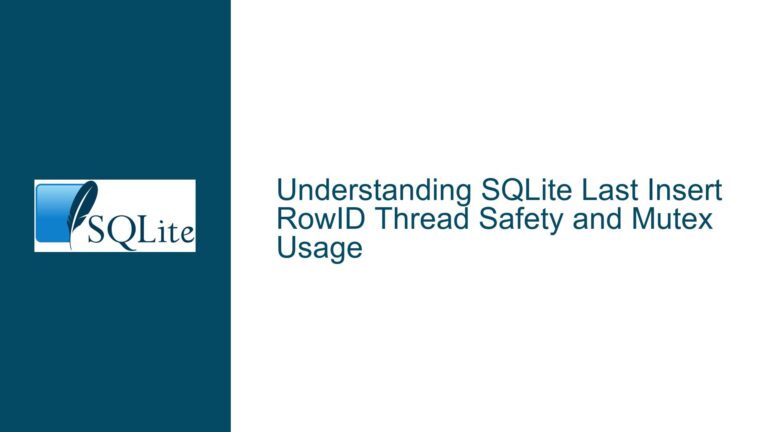EMMC Wear and Tear from Frequent SQLite Writes: Analysis and Solutions
Understanding EMMC Wear and Tear in High-Frequency SQLite Write Scenarios
When dealing with embedded systems, particularly those utilizing eMMC (embedded MultiMediaCard) storage, one of the most critical concerns is the longevity and reliability of the storage medium. eMMC, like other forms of flash memory, has a finite number of write cycles before it begins to degrade. This degradation is often referred to as "wear and tear." In the context of SQLite, a lightweight and widely-used database engine, frequent write operations can exacerbate this issue, especially when the database is expected to handle high-frequency data ingestion, such as writing CAN (Controller Area Network) data every second.
The core issue revolves around whether writing data to an SQLite database stored on eMMC at a rate of once per second will lead to premature wear and tear of the eMMC storage. Additionally, it raises the question of whether SQLite is the appropriate choice for this use case, given the constraints of eMMC storage.
To fully understand the implications, we need to delve into the mechanics of eMMC storage, the behavior of SQLite during write operations, and the interplay between the two. eMMC storage is a type of NAND flash memory, which is known for its limited write endurance. Each cell in a NAND flash memory can typically withstand between 1,000 to 100,000 write cycles, depending on the quality and type of the memory. When these write cycles are exhausted, the cell becomes unreliable, leading to potential data corruption or loss.
SQLite, on the other hand, is designed to be a robust and reliable database engine, even in embedded environments. However, its default behavior is optimized for durability and consistency, which can lead to frequent write operations. For instance, every transaction in SQLite results in a write to the database file, and in some cases, multiple writes if the transaction involves multiple pages. This behavior, while ensuring data integrity, can be problematic when the underlying storage medium has limited write endurance.
The key to addressing this issue lies in understanding the specific characteristics of both eMMC storage and SQLite, and then devising strategies to mitigate the wear and tear while maintaining the desired level of data integrity and performance.
Factors Contributing to EMMC Wear and Tear in SQLite Write Operations
Several factors contribute to the wear and tear of eMMC storage when used in conjunction with SQLite for high-frequency write operations. These factors include the write amplification effect, the frequency of write operations, the size of the database, and the specific configuration of SQLite.
Write Amplification Effect: Write amplification is a phenomenon where the actual amount of data written to the storage medium is greater than the amount of data intended to be written by the application. In the context of SQLite, this can occur due to the way SQLite manages its database file. For example, when a transaction is committed, SQLite may write not only the data but also the journal file, which is used to ensure atomicity and durability. This results in more data being written to the eMMC than the actual data being stored, thereby increasing the wear on the storage medium.
Frequency of Write Operations: The frequency of write operations is directly proportional to the wear and tear on the eMMC storage. In the given scenario, where CAN data is written every second, the number of write operations per day can be substantial. Assuming a constant rate of one write per second, this translates to 86,400 write operations per day. Over time, this can lead to a significant number of write cycles being consumed, especially if the eMMC storage has a lower endurance rating.
Size of the Database: The size of the SQLite database also plays a role in the wear and tear of eMMC storage. A larger database file means that more data is being written and potentially rewritten during transactions. In the given scenario, the maximum size of the database file is 200MB. While this may seem relatively small, the constant writing and rewriting of data within this file can still contribute to wear and tear, particularly if the data is not evenly distributed across the storage medium.
SQLite Configuration: The configuration of SQLite can significantly impact the number of write operations and, consequently, the wear and tear on the eMMC storage. For example, the use of WAL (Write-Ahead Logging) mode in SQLite can reduce the number of write operations by allowing multiple readers and a single writer to access the database simultaneously. However, WAL mode also introduces additional files (the WAL file and the shared-memory file) that need to be managed, which could potentially increase the wear on the storage medium if not configured properly.
eMMC Wear Leveling: eMMC storage typically includes a wear-leveling mechanism, which is designed to distribute write operations evenly across the memory cells to prevent any single cell from wearing out prematurely. However, the effectiveness of wear leveling depends on the specific implementation and the amount of free space available on the storage medium. If the database file is large relative to the available storage, the wear-leveling mechanism may not be as effective, leading to uneven wear and potential premature failure of certain cells.
Power Failures and Data Integrity: Another factor to consider is the impact of power failures on data integrity and eMMC wear. SQLite is designed to ensure data integrity even in the event of a power failure, but this often requires additional write operations to the journal or WAL file. These additional writes can contribute to wear and tear, especially if power failures are frequent.
Mitigating EMMC Wear and Tear in SQLite Write Operations: Strategies and Solutions
To mitigate the wear and tear on eMMC storage when using SQLite for high-frequency write operations, several strategies can be employed. These strategies range from optimizing SQLite’s configuration to leveraging alternative storage solutions or hybrid approaches.
Optimizing SQLite Configuration: One of the most effective ways to reduce wear and tear on eMMC storage is to optimize SQLite’s configuration to minimize the number of write operations. This can be achieved by enabling WAL mode, which reduces the number of write operations by allowing multiple readers and a single writer to access the database simultaneously. Additionally, increasing the page size of the SQLite database can reduce the number of write operations by allowing more data to be written in a single operation. However, it’s important to note that increasing the page size may also increase the amount of data written in each operation, so it’s essential to find the right balance.
Using a RAM Disk for Temporary Storage: Another strategy is to use a RAM disk for temporary storage of the CAN data before writing it to the SQLite database on eMMC. This approach can significantly reduce the number of write operations to the eMMC storage by buffering the data in RAM and writing it to the database in larger batches. For example, instead of writing data every second, the data could be buffered in RAM and written to the database once per minute or once per hour. This approach not only reduces the wear on the eMMC storage but also improves the overall performance of the system by reducing the frequency of write operations.
Implementing a Hybrid Storage Solution: A hybrid storage solution that combines the use of eMMC storage with other types of storage, such as an external SSD or a network-attached storage (NAS) device, can also help mitigate wear and tear. In this approach, the SQLite database could be stored on the external storage device, while the eMMC storage is used only for temporary data or as a cache. This approach reduces the number of write operations to the eMMC storage, thereby extending its lifespan.
Monitoring and Managing Write Cycles: Regularly monitoring the number of write cycles on the eMMC storage can help identify potential issues before they lead to data loss or corruption. This can be achieved by using tools that provide insights into the health of the storage medium, such as SMART (Self-Monitoring, Analysis, and Reporting Technology) for SSDs. By monitoring the write cycles, it’s possible to take proactive measures, such as redistributing data or replacing the storage medium, before it becomes a problem.
Using a Database with Built-In Wear Leveling: Some database engines are specifically designed to work with flash storage and include built-in wear leveling mechanisms. These databases can automatically distribute write operations evenly across the storage medium, reducing the risk of premature wear and tear. While SQLite does not have built-in wear leveling, it can be combined with other tools or libraries that provide this functionality.
Reducing the Frequency of Write Operations: In some cases, it may be possible to reduce the frequency of write operations by aggregating data before writing it to the database. For example, instead of writing each CAN data point individually, multiple data points could be aggregated and written as a single record. This approach reduces the number of write operations, thereby reducing the wear on the eMMC storage.
Using a Different Storage Medium: If the wear and tear on the eMMC storage is a significant concern, it may be worth considering the use of a different storage medium, such as an SSD or a hard drive. These storage mediums typically have higher endurance ratings than eMMC storage and can handle a larger number of write cycles. However, it’s important to consider the trade-offs, such as increased power consumption, size, and cost, when choosing a different storage medium.
Implementing Data Compression: Data compression can also help reduce the amount of data written to the eMMC storage, thereby reducing wear and tear. By compressing the data before writing it to the database, the number of write operations can be reduced, especially if the data is highly compressible. However, it’s important to consider the trade-offs, such as increased CPU usage and potential latency, when implementing data compression.
Using a Log-Structured Database: A log-structured database is a type of database that writes data sequentially to a log file, rather than updating data in place. This approach can reduce the number of write operations and improve the performance of the database, especially in high-frequency write scenarios. While SQLite is not a log-structured database, it can be combined with other tools or libraries that provide this functionality.
Conclusion: In conclusion, while writing CAN data every second to an SQLite database stored on eMMC can lead to wear and tear, there are several strategies that can be employed to mitigate this issue. By optimizing SQLite’s configuration, using a RAM disk for temporary storage, implementing a hybrid storage solution, and monitoring write cycles, it’s possible to extend the lifespan of the eMMC storage while maintaining the desired level of data integrity and performance. Additionally, considering alternative storage mediums or database engines with built-in wear leveling can provide further protection against premature wear and tear. Ultimately, the best approach will depend on the specific requirements and constraints of the application, but with careful planning and implementation, it’s possible to achieve a balance between performance, durability, and longevity.






